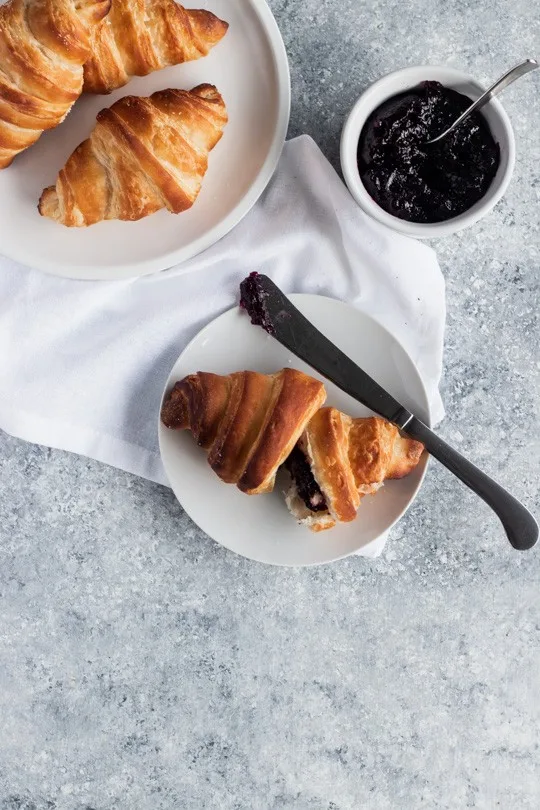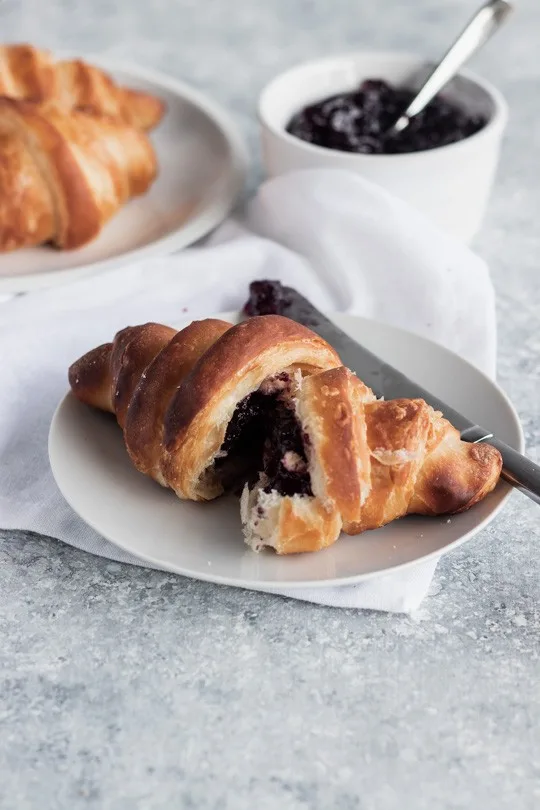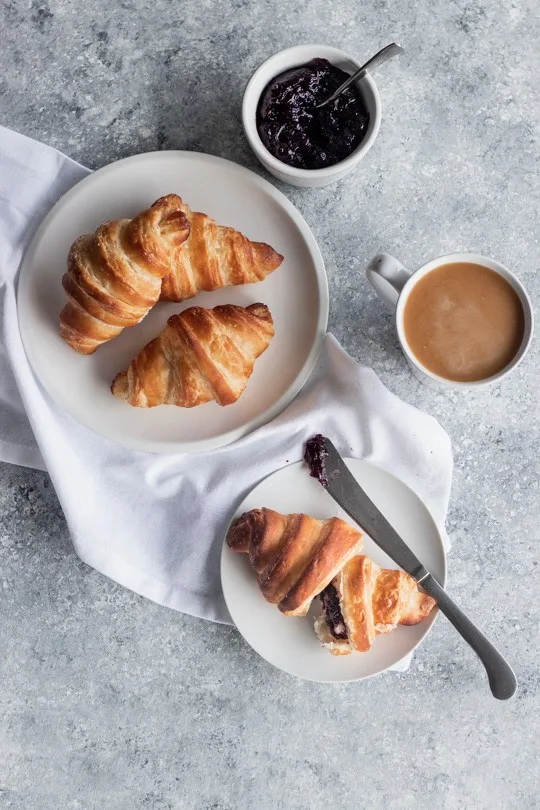A traditional flaky, buttery croissant recipe, these are worth every minute and gram of butter. A perfect baking project for a weekend brunch.

Every time we’re in France, I pretty much eat my weight in croissants. And while that may seem like it would cause clothing fit problems, the fact that I walk miles every day to find them seems to help balance things out. I also wouldn’t mind going shopping in Paris if I had to, though I’d prefer it wasn’t because I out-croissanted my old ones.
But since I can’t live in Paris (sad, isn’t it?), I’ll just have to make my own croissants. And several years of testing have left me with a recipe I really like and seems to work every time. Don’t let them fool you–croissants may have the reputation of being “hard,” but with a little practice and effort, they really are achievable.

The Basics of Croissant Making
- There are two elements to a croissant. The first is a yeasted dough, which is folded and rolled out with layers of butter. This process is called lamination, and it gives you the flaky layers and buttery flavors that croissants are known for.
- The second component of croissants — the butter layer– is a butter block, or in French a beurrage. This part is honestly the trickiest part of croissants, but definitely something that can be mastered.
- Lamination is achieved through a process called turning. Essentially, you will roll out the dough into a long rectangle, then fold it over in what is called a letter fold. The process will be repeated three times, with refrigeration between each turn. And then..
- …you get to shape your croissants! This is the fun part. If you want traditional croissants, you’ll cut the dough into large triangles. If you’re going for pain au chocolat (highly recommend them), you’ll cut rectangles and roll them up with chocolate rods. Let them rise for a couple of hours.
- And last, you’ll bake them. A quick shot of high heat to really get that yeast working, then turn them down so that they can get nice and fluffy inside without burning outside. Don’t be afraid of a slightly dark crust, but also don’t burn them. That’s a tragic way for croissants (and a lot of hard work!) to end.
- Actually, there’s one more step… eat them. Eat them ALL. As soon as possible, because croissants are definitely best the day they’re made. And sharing with friends is recommended too.
- Once you’ve mastered the art of croissant making, take things to the next level and check out this delicious cruffin recipe. It combines the best of croissants and muffins into one amazing blend.

Tips for Perfect Croissants
- The most important part of croissants is, obviously, the butter. I recommend using a European style butter because they have a higher fat content (which means less moisture) than American butter. Plugra and President are some great options available in most grocery store. Trader Joes also has butter imported from Brittany, and it’s very good and affordable.
- Another thing worth talking about is butter temperature. It’s important that your butter stays cold enough that it won’t melt into the yeast dough, but it also needs to be somewhat pliable. A rock hard butter block will simply shatter when you try to roll it into your dough, leaving you with chunks instead of sheets running throughout your dough. Try to get it to a stage where it’s chilled but can still be bent.
- A classic croissant dough has 27 layers in the dough. To achieve that, start with a square butter block, wrap it in the dough, then roll it into a rectangle before beginning your turns. The first letter fold gives you three layers and it multiplies from there. So the second will be 9 layers, and the final turn will give you the 27 layers. Because the folding creates layers exponentially, don’t be tempted to keep going. You may end up with all of the butter disappearing into the dough if you do.


Basic Croissant Recipe
- Total Time: About 20 hours
- Yield: 12 croissants, 8 pain au chocolate 1x
Description
A traditional flaky, basic buttery croissant recipe, these French classics are worth every minute and gram of butter. A perfect baking project for a weekend brunch.
Ingredients
- 1 1/2 cups (12 oz/339 g) whole milk
- 1/4 cup (50 g) white sugar
- 1 Tbsp. + 1 tsp. (11 g) yeast
- 2 1/2 tsp. (15 g) sea salt
- 4 1/4 cups (510 g) all-purpose flour, plus more for the butter block and rolling
- 1 cup + 6 Tbsp. (310 grams) butter (see notes)
Instructions
For the Dough:
In the bowl of a stnad mixer fitted with a dough hook, combine the flour, sugar, yeast, and salt. Whisk them together to combine, then pour in the milk while the mixer runs on slow. Continue to mix until all of the flour is incorporated, then turn it up to medium speed and mix until the dough is smooth and elastic, about 5 minutes.
Place the dough in a clean bowl, cover with a kitchen towel and let it rise for about an hour, or until it is slightly puffy and soft. Place it in the fridge for at least an hour, or overnight if you can.
For the butter block:
Prepare two pieces of parchment paper. Lay one on your work surface and sprinkle it generously with flour. Lay out your butter on the floured parchement– it should be cold but not completely firm, or it will just break up into chunks. If you’re using sticks, cut them in half lengthwise and lay them side by side.
Sprinkle the top of the butter generously with flour, lay the other sheet of parchment on top, and gently bash it/roll out with a rolling until it is about 8″x8.” Set it in the refrigerator until the dough is ready.
To Laminate the Dough:
On a floured surface, roll out the dough into a square about 10″x10″, then lay your butter block on top an angle, so that you have a diamond on top of a square. Pull the edges of the dough up and around the butter, pinching at the seams to seal it in.
Next, take your rolling pin and gently tap up and down along the dough, beginning to spread out the butter and pushing it out into a more rectangular shape. Gently roll the dough in one direction strokes (not going back and forth over it) until you have a rectangle measuring 18″x10″. Fold one third of the end of the rectangle over the center, then follow with the other end. The dough will be folded like a letter. Wrap it well in plastic wrap, then place it in the refrigerator for about 30 minutes.
Remove the rolling/folding/refrigerating process 3 times, then your dough is ready to shape.
To Shape Traditional Croissants:
Cut the dough in half, and roll each half into a sheet of dough 12″x8″. Cut alternating triangles in the dough with 4″ wide bases. Cut a slit 1/2″ deep in the middle of the long side of each one, then roll it up with one hand while holding and gently stretching the point of the triangle with the other hand.
Set each croissant on a parchment lined baking sheet, cover them with a clean plastic bag and allow them to rise for 1-2 hours, or until the dough is puffy and soft.
Brush the tops of the croissants with milk. Bake at 425F for 8-10 minutes, then reduce the heat to 375F and continue baking for another 15-20 minutes, or until the outsides are a deep golden brown.
To Shape Pain au Chocolat:
Roll half of the dough out into a rectangle that’s 12″x8″ and cut it into strips 3″ wide. Place a rod of chocolate on each end and roll them up until the meet in the middle. Place each pain au chocolate roll side down on a parchment lined baking sheet and cover them with a clean plastic bag. Allow them to rise for 1-2 hours, or until the dough is puffy and soft.
Brush the tops of the croissants with milk. Bake at 425F for 8-10 minutes, then reduce the heat to 375F and continue baking for another 15-20 minutes, or until the outsides are a deep golden brown.
Notes
- The most important part of croissants is, obviously, the butter. I recommend using a European style butter because they have a higher fat content (which means less moisture) than American butter. Plugra and President are some great options available in most grocery store. Trader Joes also has butter imported from Brittany, and it’s very good and affordable.
- Another thing worth talking about is butter temperature. It’s important that your butter stays cold enough that it won’t melt into the yeast dough, but it also needs to be somewhat pliable. A rock hard butter block will simply shatter when you try to roll it into your dough, leaving you with chunks instead of sheets running throughout your dough. Try to get it to a stage where it’s chilled but can still be bent.
- A classic croissant dough has 27 layers in the dough. To achieve that, start with a square butter block, wrap it in the dough, then roll it into a rectangle before beginning your turns. The first letter fold gives you three layers and it multiplies from there. So the second will be 9 layers, and the final turn will give you the 27 layers. Because the folding creates layers exponentially, don’t be tempted to keep going. You may end up with all of the butter disappearing into the dough if you do.
- Prep Time: 1 hour, divided, plus 15-18 hours of rising
- Cook Time: 20-28 minutes
- Category: Bread and Pastry
- Method: Baking
- Cuisine: French

What Is The Butter Block For Croissants Called: Unveiling The Secret Ingredient
Tuesday 19th of September 2023
[…] How to Make Traditional Croissants – Good Things Baking Co […]
The Best Almond Croissants - Good Things Baking Co
Friday 21st of May 2021
[…] crisp, flaky exterior. If you want to make an almond croissant recipe from scratch, I’ve got a croissant recipe and tutorial for you! However, purchasing croissants from a bakery works well too-these actually came from […]
Raspberry Chocolate Croissants - Good Things Baking Co
Wednesday 29th of January 2020
[…] has been sitting here for over a year. It worked beautifully, but I wanted to be more thorough with my basic croissant recipe and make sure that I had something I really LOVED before putting them out in the world. Also, […]
Cheddar, Bacon, and Caramelized Onion Quiche - Good Things Baking Co
Sunday 8th of December 2019
[…] CroissantsCinnamon Swirl BreadPeppermint Bark Stuffed French Toast […]
Chocolate Dipped Viennese Whirls - Good Things Baking Co
Monday 25th of November 2019
[…] Cinnamon RollsHow to Make CroissantsThe Best Chocolate Chip Cookies […]